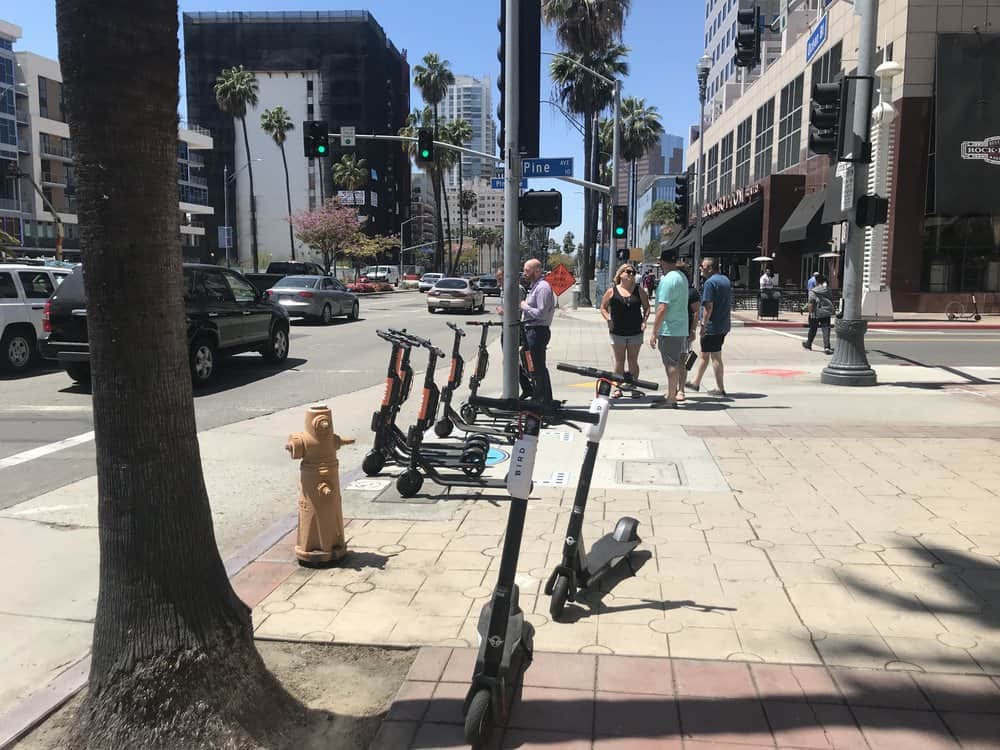
The electric scooters and dockless e-bikes flooding cities offer exciting opportunities for reducing car usage, but municipalities are struggling to retain authority over the public right-of-way and ensure emerging privatized options are safe and accessible.
“Over the past 10 years, the government has been under assault by the private sector deploying transport systems and platforms,” said Larry Yermack, an adviser with Cubic Transportation Systems, a smart transportation payments provider. “The broader discussion is what is the appropriate role for government that is responsible for public transport and private companies that [own] the platforms?”
Yermack was one of several panelists who participated in a discussion about micro-mobility and connectivity trends and challenges the morning of April 25 during the Advanced Transportation Expo in Long Beach.
Jordan Gildersleeve, senior business development associate for Jump, a dockless bike share provider acquired by Uber last year, provided an overview of the dockless e-bike service’s impact on transportation use. The average Jump trip is 2.6 miles, he said. That data point represents 45 percent of all U.S. car trips and suggests that dockless bikes can serve as an important tool for what Gildersleeve described as the end game – getting people out of their single occupancy vehicles.
Uber has come under fire for contributing to traffic congestion and a decline in public transportation ridership. But in San Francisco, two-thirds of Jump trips occur during commuter hours, Gildersleeve said, and Uber car trips declined 10 percent when Jump was introduced. “People are switching from Uber and taking Jump,” he said.
Making micro-mobility services safe is a priority for the City of Long Beach, said mobility officer Michelle Mowery. She described the results of the city’s pilot e-scooter program that has put 1,000 scooter on city streets. “The number one complaint,” she said, “is scooters on the sidewalk.”
Participating scooter vendors (including Lime, Spin and Bird) are supposed to alert users when they open up the app that they can’t ride on the sidewalk, said Mowery. But in a survey conducted by the city, 51 percent of users said they were not notified and 21 percent were not sure. “So now we know,” said Mowery. “Seventy-five [72] percent of users don’t know the rules.”
Long Beach is a leader in navigating the relationship between public management and private mobility platforms.
The city helped pioneer the use of drop zones, places where at least once a day the scooters are collected in order to clean up the right of way. And as Long Beach scales up the use of scooters from 1,000 to 4,000, Mowery said, the plan is to pursue broader and more equitable distribution, including breaking the city into six zones to ensure the scooter fleet is available across those zones..
Panelists said next-generation mobile payment systems can be leveraged as a tool to get more people to use micro-mobility options. “The fact is today payment is not just back offices, they are a significant lever and offer an opportunity to manage the transportation network,” Yermack said.
Uber is moving toward a mobility as a service model where app users get estimated travel times and prices for different transportation modes, said Gildersleeve. Yet concerns have already surfaced around ownership and management of these new business models.
Moderator Gene Oh, president of BikeHub, raised the specter of the “Walled Garden,” a term used to describe a technology platform that limits the options available to those selected by the company (think Apple’s App Store).
In the transportation arena, public buses are especially vulnerable to the walled garden conundrum, as most mobility services are private, not public.
Gildersleeves said Uber has started a pilot transit project in Denver to help people solve multiple transportation problems, and to leverage bike and scooter use to boost transit ridership. Payment flows through the app, but is pocketed by the transit agency, he said.
From a technical perspective, integrating multiple public and private services on a single platform is easy, said Yermack. “It’s a political challenge,” he said.
“How many apps do you have on your phone that are private and how many are public?” he asked. “For me the ratio is 40 to nothing.”











